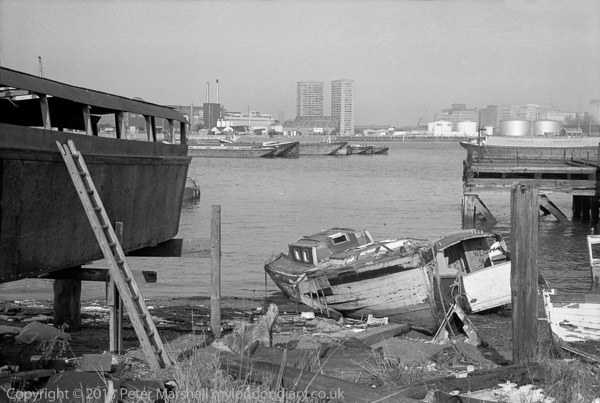
Looking across Bugsby’s Reach in 1982
Here is an e-mail I sent yesterday:
================================================
To: alistair.gale@pla.co.uk
Dear Alistair Gale,
I write to register my opposition to the proposed name change.
As someone who has known Bugsby’s Reach since the late 1970s, often walking the riverside path I feel that the name Bugsby’s Reach should be retained. I state some reasons below
1. Bugsby’s is a name that is genuinely a part of our heritage, both through oral tradition dating back several probably several hundred years and recorded in a multitude of written sources including may maps, charts and literature of all kinds since 1735 as ‘Bugsby’s Hole.’
2. Bugsby’s is a locationally specific name, linked to a past usage of a specific part of the river as an anchorage, whereas the suggested replacement is generic with no real connection to this particular stretch of river.
3. Your suggestion about the historical basis of the name is contested by local historians – and the name Bugsby’s Hole indicates that this was an anchorage from the 18th century or earlier. I have yet to see evidence that Bugsby was a person, let alone that he was a market gardener. – see the article by Mary Mills at http://onthethames.net/2014/02/14/platform-defence-bugsbys-reach/ in ‘On the Thames’. You appear to be attempting to mislead respondents in your statement on this consultation.
4. I think the current name has much more character than the proposed replacement which seems bland in comparison.
5. Waterman’s Reach sounds like the kind of name property developers would give to some generic waterside development (and they have done so.)
6. There are other stretches of the Thames which would seem to me to have a greater claim to the name Waterman’s Reach, and I think if any stretch is to bear that name it should be on the course of the ‘Doggett’s Coat and Badge’ and most obviously close to Watermen’s Hall. There isn’t even a Waterman’s Pub on this stretch! Brentford could also make a good case with a Watermans Arts Centre and a pub.
7. Surely it should in any case be Watermen’s Reach and not Waterman’s Reach – which I’m afraid makes me think of fountain pens not watermen.
8. There appears to be no particular reason why Bugsby’s Reach should have been selected for oblivion. There are other reaches with names with far less character that could have been selected, for example those that are simply geographic in nature – such as Woolwich Reach. I’m not against change, but want changes that give the river greater character not reduce it.
I would like to make a positive suggestion. On my PLA map of the River Thames, Woolwich Reach is shown as extending from the PLA radio station at Charlton through the Thames Barrier to Gallions Reach. I would suggest that while Bugsby’s Reach be maintained, the short section of Woolwich Reach from Charlton to the Thames Barrier could be renamed as Watermen’s Reach. There is no need to ditch our history to commemorate “watermen, wherrymen and bargemen.”
Yours sincerely
Peter Marshall
—
Thamesgate Panoramas: http://is.gd/BASbSi
London’s May Queens: http://is.gd/Ece8v1
In Search of Atget: Paris 1984 http://is.gd/v6D4hE
Still Occupied: A View of Hull 1977-85 http://is.gd/0v2YAg
Before the Olympics: The Lea Valley 1981-2010 http://is.gd/qBQGtl
Peter Marshall – Photographer, Writer: NUJ
_________________________________________________________________
>Re:PHOTO http://re-photo.co.uk
My London Diary http://mylondondiary.co.uk/
London’s Industrial Heritage: http://petermarshallphotos.co.uk/
The Buildings of London etc: http://londonphotographs.co.uk/
River Lea/Lee Valley 1980-2010 http://river-lea.co.uk/
and elsewhere……
========================================
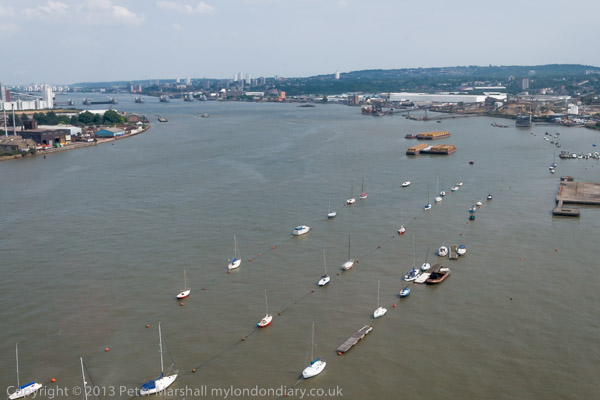
Bugsby’s Reach from the cable car, 2013
The Port of London Authority (PLA) is currently consulting over its intention to change one of the old established names for the reaches on the River Thames, Bugsby’s Reach, which extends from the tip of the Greenwich Peninsula at the Millennium Dome (O2) to Charlton.
In a document online, they state:
In commemoration of the 500th Anniversary of the 1514 Act of Parliament for regulating watermen, wherrymen and bargemen when King Henry VlIl granted Royal Assent, the Port of London Authority intends to rename Bugsby’s Reach as ‘Waterman’s Reach’ at a ceremony
on 18 September 2014.
and they invite observations/representations on this to be sent by Monday, 21 April 2014 either by letter or by email to: alistair.gale@pla.co.uk
I’ve sent my comments – but if you have an opinion why not tell the PLA too.
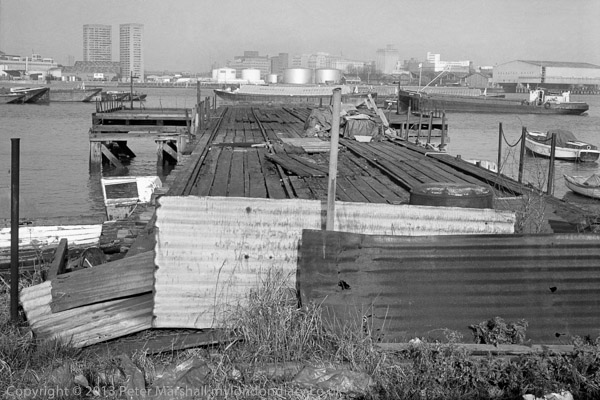
Bugsby’s Reach, 1982
You can read more about the proposed name change for this stretch of rive in Bugsby’s holed? Why a bit of Greenwich’s history is under threat on the 853 blog.
I’ve known Mary Mills who I mention in the e-mail above for a long time and have both her books on Greenwich. She also has her own blog, When she was de-selected as a councillor by the local Labour party last year, the Greenwich Phantom blogger – who says “I rarely – almost never – talk about political issues in Greenwich” was moved to post:
“Greenwich’s finest councillor by a country mile, Mary Mills, was deselected in what has to be the biggest own-goal the local Labour Party has scored in some time, and believe me there have been some pearlers… I am utterly gobsmacked that they have been so shortsighted in getting rid of the only personality that actual, real humans on the doorstep recognise and like.”
Dr Mills is also one of our leading industrial archaeologists and almost certainly has researched more about the history of the area than anyone else. If the PLA had done any local consultation about Bugsby’s Reach they would certainly have approached her. You can read her views on the change here.
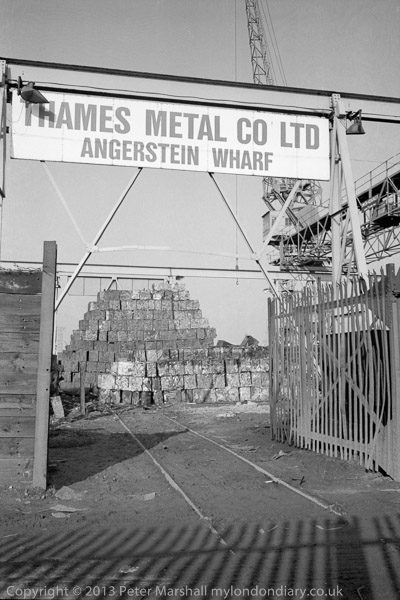
Angerstein Wharf, 1982
I can only speculate (as I often do!) why the PLA has it in for poor Bugsby’s rather than choosing any other named stretch of the river to obliterate.
Could it be because it is a name that sits uncomfortably with the property developers who want to cover every riverside plot with unsightly luxury flats to sell to overseas speculators? It has an unattractive sound – bugs, bogs, bogeys, bogles, bugbears, buggers, boggarts… none very pleasant, though perhaps related to the history of the area, which certainly was boggy and full of bugs (the land is Greenwich Marshes) and it was also a place where the bodies of executed criminals were formerly hung in chains, so doubtless a haunting ground for malevolent spirits.
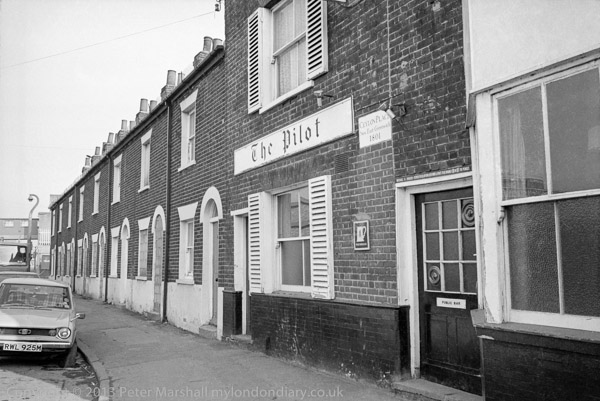
The Pilot, Ceylon Place, 1982
The Pilot, built (according to Mary Mills) in 1804 on Ceylon Place, New East Greenwich is still there, though the interior was apparently refurbished last year, and it is now a Fullers pub. It and the adjoining cottages were built on the causeway leading to Bugsby’s Hole which was given approval in 1801, the date recorded on the stone at the left of the sign. It’s name is not directly related to the river, but to Prime Minister William Pitt, described by George Canning as ‘The pilot who weathered the storm’ for his negotiation of the 1802 Treaty of Amiens which ceded Ceylon to Britain. It is no longer a Whitbread pub – and Whitbreads are no longer brewers.
______________________________________________________
My London Diary : Buildings of London : River Lea/Lee Valley : London’s Industrial Heritage
All photographs on this and my other sites, unless otherwise stated, are taken by and copyright of Peter Marshall, and are available for reproduction or can be bought as prints.
To order prints or reproduce images
________________________________________________________